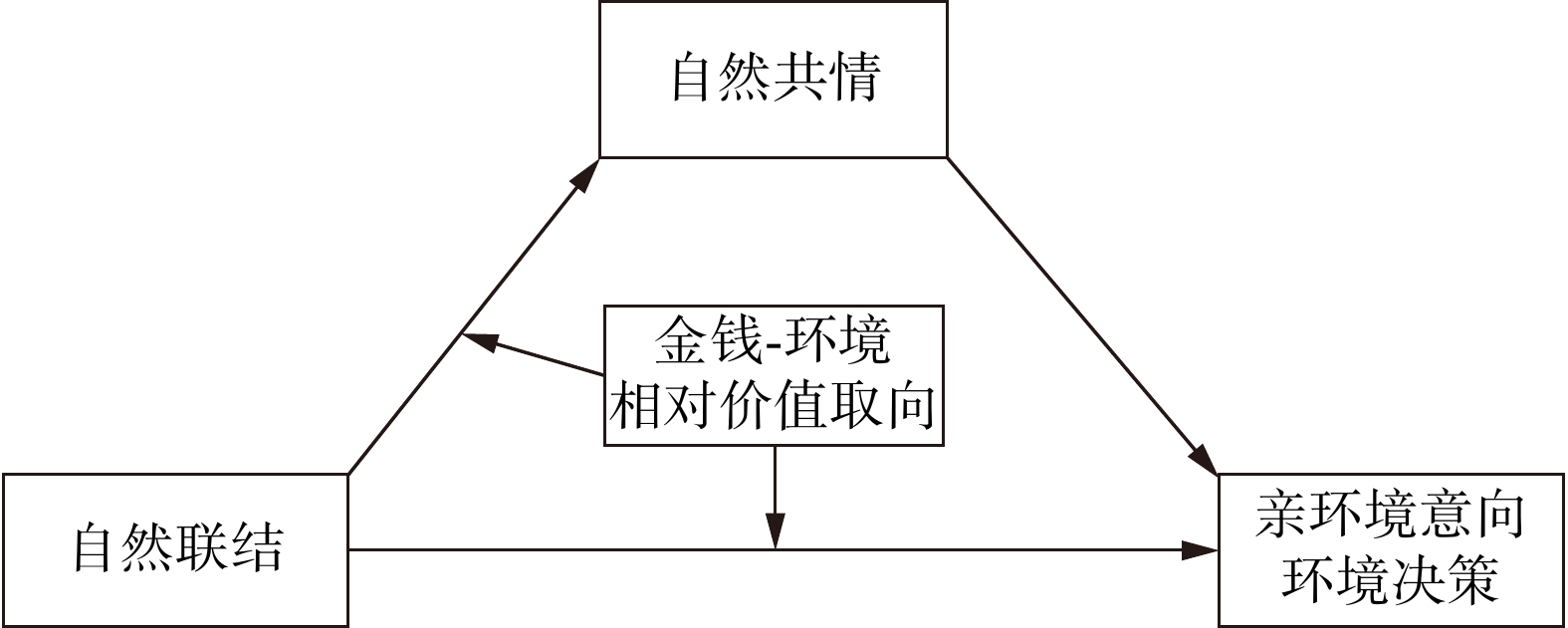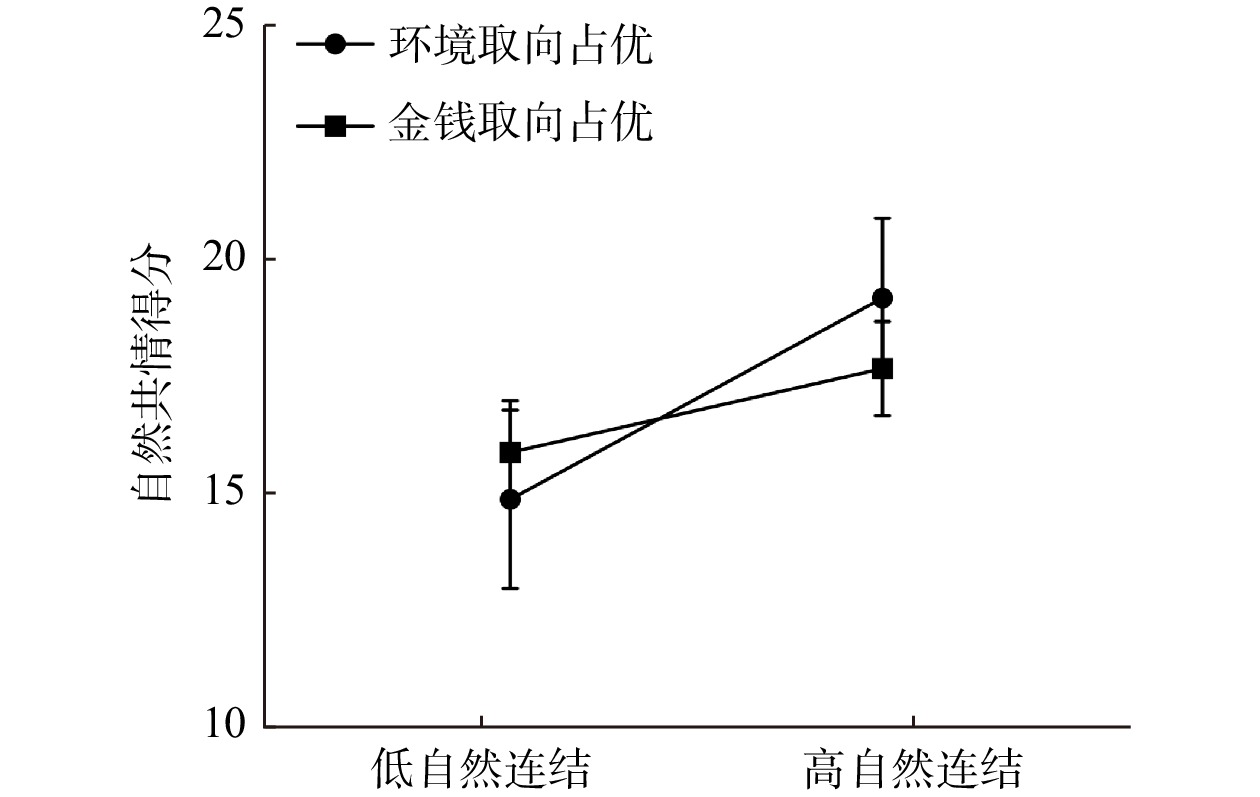The Relationship Between Nature Connection and Pro-environmental Behavior: The Mediating Role of Empathy with Nature and the Moderation Role of Relative Value Orientationation
-
摘要:
为了考察自然联结正向预测亲环境行为的内在机制,本研究从情感与认知双因素模型出发,综合考察自然共情和相对价值取向在影响个体亲环境行为过程中的影响机制。问卷调查显示,自然联结正向预测亲环境意向,自然共情起中介作用,相对价值取向调节自然联结对自然共情的影响。当环境取向占优时,自然联结对个体自然共情的影响更强,但自然联结或自然共情与环境决策之间的相关均不显著。研究为亲环境行为的情理整合模型提供了新的证明,并为亲环境研究中发现的“意向行为鸿沟”提供了实证依据,也为环境宣传工作提出了对应性建议。后续研究还需就不同因素如何影响亲环境意向到行为的转化,以及其影响有何差异进行深入探讨。
Abstract:Based on the integrated model of emotion and cognition on pro-environmental behavior, the current study is conducted in order to deeply understand the intrinsic influential mechanism of nature connection (NC) to pro-environmental behavior (PEB), within which we assume that empathy with nature (EN) plays as a mediator and relative value orientation (RVO) plays as a moderator. Results showed that NC positively predicted pro-environmental intention, EN played a mediating role, and RVO moderated the impact of NC on EN. Compared with individuals who prefer money, individuals who prefer environment had a larger difference on EN between high and low NC. However, neither NC nor EN had a significant correlation with environmental decision-making. The present study provides a new proof for the integrated model of emotion and cognition on PEB, offering empirical evidence to the gap between intention and behavior found in pro-environmental studies. The findings of this study can also provide recommendations for environmental protection awareness-raising efforts. Follow-up research needs to further explore the differences between the influence of pro-environmental intentions and behaviors.
-
Keywords:
- nature connection /
- empathy with nature /
- pro-environmental behavior
-
亲环境行为(pro-environmental behavior)是指个体尽量降低对生态环境产生负面影响的行为或积极参与有益于环境的行为。以往亲环境行为研究主要基于计划行为理论、规范激活理论、价值信念规范理论等考察认知因素在亲环境行为中的作用,但亲环境行为不仅基于理性认知,当将情感因素纳入考虑后可增加基于理性决策的模型解释率[1]。亲环境行为与敬畏感、自豪感等道德情感有关,也与自然带来的亲近感、保护自然带来的愉悦感、保护自然免遭破坏的责任感等与行为直接相关的情绪体验有关[2]。从人与自然和谐共生的视角,研究发现,自然联结、地方依恋、地方认同、自然共情等反映人与环境间关系的环境情感因素与亲环境行为有关[3-5]。
在测量形式上,以往关于亲环境行为的测量多以自我报告的形式进行。然而,近来研究表明以自我报告的形式测量亲环境行为存在一些不足[6-7],Kormos等[8]通过元分析指出自我报告的亲环境行为只能解释实际行为21%的变异。比如,同样是对“您多久回收一次纸张”这一问题,不同被试可能对“纸张”“回收”甚至频率程度如“经常”的定义存在个体差异,或者人们在生活中缺乏对这一问题的关注,造成实际回收纸张频率很高的某人报告的回收频率低于实际值[9]。因此有研究者指出,使用自陈量表测量的亲环境行为更有可能反映了个体的亲环境倾向[10]。
综上,有必要探索亲环境行为更有效的测量方式。本研究关注环境决策这一与环境保护有关的任务,以环境决策作为个体亲环境行为的实际表现。有研究基于旅行、消费等现实情境,发现在这些现实情境中个体的环境决策受到新生态范式、预期内疚或自豪等认知情感因素的影响[11-12]。另有研究使用兼顾金钱-环境复合收益和跨期收益的环境决策范式,发现环境保护身份认同、金钱-环境相对价值取向等多种因素都对环境决策结果存在影响[13-14]。相比较而言,金钱-环境复合决策强调亲环境行为付出的金钱成本,体现出人们做出的亲环境行为是基于多角度评估的选择和决策过程,更接近实际的亲环境行为。因此,本研究结合亲环境行为的主观报告和金钱-环境复合决策任务,探究环境认知因素相对价值取向与环境情感因素自然联结及自然共情在亲环境行为意向及决策中的综合作用,并基于共情利他假说考察亲环境行为的内在机制。
自然联结描述了人与自然之间的亲密关系,即情感上对自然产生依恋,认知上将自然与自我合为一体和身体体验上感受到自然的吸引力[15-16]。众多实证研究表明,自然联结可正向预测亲环境行为[17-18]。据此,本研究提出假设1,H1a:自然联结正向预测个体亲环境意向;H1b:自然联结影响个体环境决策偏好,高自然联结者有更多的亲环境决策。
不过,虽然有研究发现自然环境接触、想象身处绿色环境之中的正念练习可提高个体的自然联结水平,并进而对亲环境行为产生促进作用[19-20],但元分析研究显示,自然联结的实验操纵对亲环境行为的影响仅具有小效应[17],提示两者之间的因果关系尚不明确,可能存在其他中间变量。自然共情反映人们感受并共享自然界,尤其是处于困境中的自然界的体验的能力。与自然联结相比,自然共情更强调对自然“痛其所痛”的能力和敏感性[21]。根据共情利他假说[22],旁观他人处于困境会唤醒个体的怜悯、同情等情绪,进而激发个体的利他行为。亲环境行为具有利他性,大量研究表明自然共情对个体的亲环境行为有直接或间接的正向预测作用[3,21,23]。自然联结与自然共情对个体亲环境行为都有显著影响,且两者之间存在相关性[24]。自然联结包含了情感上人与自然之间的积极依恋关系,社会心理学研究显示安全依恋有助于共情[25],提示高自然联结人群可能更容易对处于困境中的自然客体或整体自然环境产生共情反应。
因此,自然共情可能在自然联结与亲环境行为之间起中介作用。据此提出假设2,H2a:自然共情在自然联结对亲环境意向的影响中起中介作用,自然联结正向影响自然共情,进而正向预测个体亲环境意向;H2b:自然共情在自然联结对个体环境决策偏好的影响中起中介作用,自然联结正向影响自然共情,高自然共情者有更多的亲环境决策。
亲环境行为与个体各种亲环境特质有密切关系。然而在现实生活中,人们决定做出亲环境行为时却不只出于对环境保护的考虑,还受到其他复杂因素的制约。比如,在购买商品时,环境友好型商品的价格可能略高于同类普通商品,这可能降低了人们的购买动机[26];另外,由于亲环境行为对环境的积极作用需要较长时间的积累才能被感知到,而且效果的大小也是不确定的,因此对那些看重当下稳定收益的个体来说,未来不确定的环境收益缺乏吸引力[13,27]。
基于此,本研究认为个体关于环境和金钱的价值取向在影响其亲环境行为过程中可能存在调节作用。金钱-环境相对价值取向反映了个体对环境和金钱的相对价值判断,对环境决策、经济决策和亲环境行为都有显著预测作用[28-29]。根据亲环境行为的认知情感整合模型可知,情感因素是影响个体亲环境行为的远端变量,它将通过影响认知、态度等对当下情境中的亲环境行为产生作用[30],提示情感因素和认知因素在亲环境行为产生过程中的交互作用。以往研究也发现除情感影响认知的路径外,环境关心等认知因素也会通过影响环境敏感性和地方依恋等情感因素对亲环境行为产生影响[31],说明情感-认知的相互作用是复杂的。以往关于价值取向这一认知因素是如何与情绪情感因素交互影响、发挥作用的研究结论也存在矛盾和分歧[32-33],提示两者之间的相互作用可能存在情境差异,需要具体问题具体分析。
然而以往关于亲环境的认知情感双因素模型的研究主要关注一些存在相互影响的认知和情感因素,对亲环境行为的影响主要是通过中介路径完成的[30],关于相对价值取向与情感因素的交互作用研究并不多且结论不一。因此有必要讨论金钱-环境相对价值取向与自然联结这一情感因素在对亲环境行为意向和环境决策的影响中是否存在交互作用,从而更好地理解情感因素和认知因素。据此提出假设3,H3a:金钱-环境相对价值取向调节自然联结对自然共情的影响,环境取向占优者自然联结对自然共情的影响高于金钱取向占优者。H3b:金钱-环境相对价值取向调节自然联结对亲环境行为意向和环境决策的影响,环境取向占优者自然联结对亲环境行为意向和环境决策的影响高于金钱取向者。
前人研究已经证明了自然联结、自然共情和金钱-环境相对价值取向对个体亲环境行为存在影响,初步搭建起了变量之间的桥梁。然而,以往研究并没有整合上述变量,探索变量间的协同作用。结合现实生活中存在的种种亲环境行为“明知可为而不为”的现象,我们认为本研究的创新之处在于将自然联结、自然共情两个情感因素与金钱-环境相对价值取向这个认知因素结合起来,构建影响亲环境行为的一个整合模型,作为对以往研究的补充。此外,许多研究也证实了亲环境意向到行为之间存在鸿沟,即“虽愿但实不为”的现象,但具体何种原因导致了这一现象目前尚未有定论。本研究也希望立足上述讨论,探究究竟是情感因素还是认知因素影响了亲环境意向到行为的转变过程,以加深对意向行为鸿沟的理解。总体而言,本研究基于影响亲环境行为的认知情感双因素模型,综合考察自然联结与自然共情两个情感因素对亲环境行为的影响,并探究金钱-环境相对价值取向这一认知因素是否起到调节作用(如图1所示)。
一. 方 法
一 被 试
经过效应量计算程序G*power 3.1计算, 本研究需要 N ≥ 204 的样本量以达到效应量为0.25、α = 0.05、统计检验力为0.9的统计检验水平。研究主要采取方便取样和滚雪球抽样法,通过“问卷网”平台发布问卷,并在国内各高校学生间宣传。被试在网上自行阅读知情同意书,然后依次完成亲环境行为量表、环境决策任务、自然联结量表、金钱伦理量表、自然特质共情量表和新生态范式量表,最后填写个人信息。经主试审核后,被试将获得相应报酬。
研究共回收241份答卷,对原始数据进行质量清洗,共删除15份无效问卷(包括无效填答、规律填答和极端答案),最后共获得有效样本 226个,这些被试平均年龄27.21岁(标准差为 4.93),其中男性124名。
二 测量工具
1 自然联结
采用李娜等修订的自然联结量表[34],包括“我常感觉与大自然融为一体”等14个题项。题项均为5点评分,其中1表示“非常不同意”,5表示“非常同意”。得分越高,被试的自然联结水平越高。该量表的内部一致性系数为0.78,重测信度相关系数为0.90。
2 自然特质共情
参考宗阳等译制改编的自然特质共情量表[35],包括“我感觉到自己就是这些动植物”等8个题项。题项均为5点评分,其中1表示“非常不同意”,5表示“非常同意”。得分越高,被试的自然特质共情水平越高。该量表的内部一致性系数为0.90。
3 相对价值取向
采用吴灵琼等编制的大学生版新生态范式量表来测量环境价值取向[36],包括“人类正在滥用和破坏环境”等15个题项,均为5点评分,其中1表示“非常不同意”,5表示“非常同意”。该量表的内部一致性系数为 0.72。采用赵秋荻修订的金钱伦理量表来测量金钱价值取向[29],包括“金钱是成功的标志”等12个题项,均为7点评分,其中1表示“非常不同意”,7表示“非常同意”。该量表的内部一致性系数为 0.74。用每位被试在两个量表上的标准分相减得到的差值ΔV,表示被试的相对价值取向[8]。ΔV大于0,表示金钱取向占优;ΔV小于0,表示环境取向占优。
4 亲环境行为量表
采用龚文娟编制的亲环境行为量表[37],要求被试回忆过去一年中做出亲环境行为的频率,包括2个维度、8个题项。其中公领域亲环境行为维度包括“为环境保护捐款”等4个题项,私领域亲环境行为维度包括“在采购日常用品时自带购物袋”等4个题项。题项均为5点评分,1代表“从不”,5代表“经常”,得分越高表示被试平时的亲环境行为频率越高。该量表的内部一致性系数为 0.72。
5 环境决策任务
采用陈嘉欣等提出的金钱-环境复合结果范式[13]。以往研究表明,“确定获得 21 天的优质室内空气”所代表的环境收益E在心理感受上大致相当于“确定获得 1 226 元”所代表的金钱收益M [13]。 因而本研究采用“获得21天优质室内空气”作为环境收益E,“获得1 226元”作为金钱收益M。
基于此,在本研究中首先呈现一段空气质量相关的知识,然后请被试在4种不同条件下完成环境决策任务。本任务分为结果量匹配和概率匹配两种情境,每种情境又区分了金钱和环境结果两种情况(表1)。两种情境均设定了两个选项,一项为确定选项,即“同时获得金钱收益M和环境收益E”,另一项为调节选项。任务要求被试补全调节选项,使得补全后两种选择在心理感受上一样舒适。不同的是,两种情境设定了不同的条件。在结果量匹配的情境中,有55%的概率同时获得一定的金钱和环境收益,45%的概率收益为零[13]。此时要求被试调整金钱收益(记为XM)或环境收益(记为XE),使其分别与确定选项在心理感受上一样。在概率匹配情境中,金钱收益M或环境收益E的值是固定的,此时要求被试调整金钱收益翻倍但环境收益不变(记为P1)、环境收益翻倍但金钱收益不变(记为P2)发生的概率,使其分别与确定选项在心理感受上一样。
表 1 环境决策任务调节方式 环境决策指标
(因变量)指标涵义 任务情境1(调节金钱) 任务情境2(调节环境) 结果量调节匹配 α = (XM/M)/(XE/E) 两类收益价值的比较,α越大,相较金钱收益个体更看重环境收益的价值 “以55%的概率同时获得_元(记为XM)和21天优质室内空气”等价于“确定同时获得1226元和21天优质室内空气” “以55%的概率同时获得1226元和_天(记为XE)优质室内空气” 等价于“确定同时获得1226元和21天优质室内空气” 概率调节匹配 β = P1 / P2 两类收益风险的比较,β越大,相较金钱收益个体更担心环境收益的风险 “以_的概率(记为P1)同时获得2452元和21天的优质室内空气”等价于“确定同时获得1226元和21天优质室内空气” “以_的概率(记为P2)同时获得1226元和42天的优质室内空气”等价于“确定同时获得1226元和21天优质室内空气” 两种匹配任务本质上都是某类结果增益与复合收益整体风险间的权衡,但对结果量的匹配更强调某类结果增益,对概率的匹配更强调复合收益的整体风险[13]。由于XM和XE、P1和P2的大小不具有直接可比性,取α = (XM/M)/(XE/E),反映个体在复合收益决策中赋予金钱和环境结果的相对权重。α 越大,表示被试用更多的金钱去弥补环境结果的概率折扣,可理解为与金钱增益相比,被试更看重环境增益的大小,是两类收益的价值比较。取β = P1/P2,反映个体对一倍金钱增量和一倍环境增量的相对重视程度。β越大,表示被试越看重复合收益中环境结果的价值,可理解为与金钱增益相比,被试更担心环境结果增益的风险,是两类收益的风险比较。
二. 结 果
一 共同方法偏差检验
本研究仅采用自陈报告法收集数据,可能会出现共同方法偏差问题,根据周浩等的建议[38],分析数据前采用Harman单因素检验进行统计控制。结果显示,未旋转的探索性因子分析结果提取出大于1的因子共14个,第一个因子解释的变异量为14.99%,小于 40%的临界值,因此本研究的数据不存在严重的共同方法偏差。
二 各变量描述性统计及相关性
对自然联结、自然共情、相对价值取向、亲环境行为量表得分与环境决策任务指标α、β进行描述性统计及相关分析,结果表明自然联结、自然共情、相对价值取向和亲环境行为量表得分两两之间存在显著相关,但自然联结、自然共情、相对价值取向与环境决策任务指标α、β相关系数均不显著(见表2)。
表 2 各变量的平均数、标准差和相关矩阵(N = 226)平均数 标准差 自然联结 自然特质共情 相对价值取向 亲环境意向 环境决策概率调节指数 自然联结 56.71 4.82 1 自然特质共情 33.85 2.73 0.54*** 1 相对价值取向 0.00 1.40 −0.53*** −0.27*** 1 亲环境意向 33.03 3.76 0.30*** 0.69*** −0.18** 1 环境决策结果调节指数(α) 1.09 0.39 0.08 < 0.01 −0.12 0.04 1 环境决策概率调节指数(β) 0.92 0.18 −0.02 < 0.01 −0.01 0.18** 0.15* 注:* 、**、 ***分别表示0.05、0.01、0.001的显著性水平。 首先对自然共情在自然联结与亲环境行为意向间的中介效应进行检验。将所有变量进行标准化处理,然后在控制性别、年龄的情况下通过SPSS宏程序PROCESS中的模型4进行中介效应分析,采用偏差校正的百分位Bootstrap方法检验,重复取样5 000次,计算95%的置信区间。结果表明自然共情中介效应显著,且为完全中介效应(β = 1.03,p < 0.001)。后对相对价值取向对中介路径和直接路径的调节作用进行检验。使用SPSS PROCESS模型8进行有调节的中介效应分析(见图2),将年龄、性别作为控制变量,结果表明相对价值取向显著调节中介路径(β = −0.06,p < 0.05),而对直接路径没有调节作用(β = −0.03,p = 0.37)。
为了进一步探究相对价值取向对中介路径的调节效果,使用SPSS PROCESS模型7进行分析。分析结果显示,自然联结显著正向预测亲环境行为,自然共情起到完全中介作用。相对价值取向在自然联结与自然共情之间起调节作用(见表3、4),金钱价值取向占优个体的自然共情中介效应小于环境取向占优的个体(见图2)。
表 3 自然共情在不同相对价值取向(ΔV)水平上的中介效应值中介变量 ΔV 效应值 Boot标准误 95%置信区间 自然共情 平均值−标准差 0.40 0.09 [0.22,0.57] 平均值+标准差 0.21 0.07 [0.08,0.34] 表 4 有调节的中介模型检验结果(N = 226)模型 结果变量 R2 F p 预测变量 标准化系数 95%置信区间 β 标准误 下限 上限 1 自然共情 0.31 33.74 < 0.001 性别 −0.54*** 0.31 −1.15 0.07 年龄 −0.06 0.03 −0.12 0.00 自然联结 0.30*** 0.03 0.24 0.37 2 自然共情 0.33 21.69 < 0.001 性别 −0.53 0.31 −1.14 0.07 年龄 −0.06 0.31 −0.12 0.01 自然联结 0.30*** 0.04 0.23 0.38 相对价值取向 3.37* 1.43 0.56 6.19 自然联结 ×
相对价值取向−0.06* 0.03 −0.11 −0.01 3 亲环境意向 0.10 8.26 < 0.001 性别 −0.21 0.49 −1.17 0.75 年龄 −0.08 0.05 −0.17 0.02 自然联结 0.23*** 0.05 0.13 0.33 4 亲环境意向 0.49 52.18 < 0.001 性别 0.35 0.37 −0.39 1.08 年龄 −0.01 0.04 −0.09 0.06 自然联结 −0.08 0.04 −0.17 0.01 自然共情 1.03*** 0.08 0.87 1.19 注:* 、**、 ***分别表示0.05、0.01、0.001的显著性水平。 使用相同方法对自然共情在自然联结与环境决策任务调节指数α、β间的中介效应进行检验,结果发现自然共情对环境决策任务调节指数α、β均不存在中介作用(β1 = −0.007,p1 = 0.54;β2 = 0.004, p2 = 0.94),因此自然共情的中介效应不成立,也未能进行接下来的有调节的中介模型分析。
三. 讨 论
一 研究结论
本研究基于共情利他假说,考察了自然联结对亲环境行为意向和环境决策的影响机制。研究结果显示自然联结和自然共情均能促进亲环境行为的意愿,自然特质共情在自然联结和亲环境行为量表得分之间起到中介作用,与前人研究结果具有一致性;但并未发现个体的自然联结、自然共情及相对价值取向与环境决策偏好的相关性。
首先,自然联结正向预测个体的亲环境意向,支持假设H1a。个体感知与自然的亲密联系是其亲环境意向的重要预测因素,这与以往研究结论一致[39]。根据Mayer等[16]的观点,自然联结让个体感知到自我和环境在利益关系上的一致性,环境受损必然带来自身利益的损害,因此个体将避免做出损害环境的行为。王财玉等[40]的研究证明,自然联结能够降低竞争性自恋带来的消极影响(如更低的宜人性、尽责性)、提升对自然孕育万物的感恩情绪,从而提高青少年的亲环境行为倾向。
其次,自然共情在自然联结特质对个体亲环境意向的影响中起完全中介作用,支持假设H2a。观点采择是自然共情最重要的成分之一[41],包括认知的观点采择和情感的观点采择。从认知的角度出发,根据资源分配理论,个体会优先将有限的认知资源分配给认为重要的信息;而自然联结的亲生命性假说认为,人类有与自然界联系的本能欲望[42],而自然联结使得亲生命的本能欲望得以满足,因而高自然联结个体表现出更高的幸福感[43]。结合上述观点可以推断:高自然联结者与自然亲近的动机更强,将更多认知资源分配给自然个体,因而能够对环境正在面临的风险进行更好的加工和理解,表现出更强的自然共情。
从情感的角度出发,关于共情的研究表明,人际关系越紧密,共情体验就越强烈[44]。近来研究也证实了自然联结的情感性因素(如自然亲近感)比认知性因素(如环境知识和自然风险认知)更能预测成人的亲环境行为意愿[45]。据此,自然共情反映了个体理解并分享有关自然世界的情感经验的倾向,一方面可以被认为是情感性自然联结的组成部分[46],另一方面也受到个体对自然的情感联结的影响。
再次,自然联结对自然共情的作用受个体相对价值取向的影响,支持假设H3a。这符合亲环境行为的情理合一观点[47],价值取向影响个体的共情能力也得到了亲社会领域研究的支持[48]。根据相互依赖理论[49],个体与他人互动的内在动机受到个人价值观的影响,它将影响个体对特定环境的知觉和认识。也就是说,在引发自然共情的过程中,自然联结使人们感受到人与自然的亲密关系,构建相互依赖的环境;而相对价值取向则影响人们对此环境的认知和解构,两者共同决定了个体对自然事物的共情能力。
然而,本研究结果显示,自然联结特质并不能很好地预测个体采取亲环境行为时的决策偏好,假设H1b、H2b、H3b未能得到验证。以往关于自然联结对个体亲环境行为的研究更多关注其对低成本的、一般性的亲环境行为或行为动机的影响[50-51],而对高成本的、具体的亲环境行为或行为决策的讨论不足。环境决策具有风险性、社会性和跨期性等特征,包括情感判断和认知估计两个过程,后者要求决策者对执行/不执行环保行为需要付出的成本和获得的收益进行评估[14],其决策过程是基于理性判断的,是有意识的、深思熟虑的结果[52-53]。由此推测,自然联结等情感因素对亲环境行为的预测效果主要表现在低成本亲环境行为上,不涉及亲环境行为的成本与利益的权衡,而对高成本的亲环境行为预测效力不足。
最后,就金钱-环境相对价值取向这一认知因素在调节自然联结对亲环境意向和环境决策中的作用,本研究亦未得出肯定结论。以往关于价值取向与自然联结影响个体亲环境行为的研究指出,亲生物价值取向和自然联结都对儿童建立生态自我认同有积极作用,从而正向预测儿童在长大后的亲环境行为[54]。环境关心等环境价值取向也被证明与个体自然联结水平有关[55]。这表明,价值取向与自然联结在影响个体亲环境行为中的共同作用在于决定人们如何看待自己、看待环境以及两者之间的关系,两者之间更多是一种共变关系。而金钱价值观主要通过影响个体对行为成本的评估影响行为意愿,因此与自然联结影响个体亲环境行为的路径有所差异。
另外,环境风险决策也是决策行为的一种,对其理解也可以借鉴决策理论。首先,安于现状偏差是一种什么都不做或维持当前或先前的决定的决策偏好,它让决策者倾向于选择他们所熟悉的选项,而相对忽视新选项潜在的成本节约[27,56]。而在本研究中的环境决策任务涉及“短期的金钱收益”与“长期的环境收益”之间复杂的权衡,环境收益使用的是“优质空气”,对大多数被试而言这一任务情景是陌生的。因此,在进行决策时他们更倾向于选择自己更为熟悉的金钱收益。这可能是在其情感上与自然亲密、认知上理解保护自然的重要性之外的一层影响,使其“明知可为,明知应为而不为”。其次,决策双系统模型指出,即使决策者有某种倾向或特质,但不熟悉达成某目标的具体措施时,基于直觉的启发式决策系统会被优先启动。比如Kempton等[57]发现,人们容易低估低频次出现的节能行为(如安装双层玻璃窗户)对能源的节约程度。这可能是因为相比较高频出现的节能行为(如随手关灯),此类行为是相对较少被提及的,因此关于其节能效果的知识也更难被唤起和提取而被给予理性的系统分析加工,在这种情况下直觉加工就会迅速启动并做出决策。
二 讨论与展望
综上,本研究建立起自然联结对个体亲环境意向的预测模型,证实了自然联结通过自然共情的完全中介作用对亲环境意向产生影响,相对价值取向在自然联结对自然共情的影响中起调节作用。研究结果支持亲环境行为的情理整合模型,进一步证实了亲环境行为的产生是情感因素和理性因素交互作用的结果。相较以往研究者更关注情感因素对认知因素的调节作用,本研究旨在表明因情感联结而产生的亲环境动机受到个体关于行为成本和利益的理性分析的影响,提示研究者未来仍应该从情理整合的视角出发,审视亲环境行为的产生过程。然而本研究表明自然联结并不能很好地预测个体在环境行为中的决策偏好,证实了亲环境意向和行为之间的背离,提示未来研究者仍应该在此方向深入挖掘,探讨两者之间差异的成因。
本研究的结果也可以对环保实践工作提供启发。一方面,本研究支持了自然联结、自然共情对亲环境意向的促进作用,提示在进行环保宣传时应以促进人与自然的亲密关系为抓手,从情感上促使人们“知其应为而愿为”的行动。同时,研究结果指出,金钱-环境相对价值取向调节了个体实施亲环境行为的意愿,也对当下面临转型的企业决策者有所启示。目前国家大力推动绿色经济,追求经济收益和环境保护的双赢,强调“绿水青山就是金山银山”。对企业决策者而言,有必要深入思索企业的金钱和环境价值观的相关性问题,从而更好地做出各类决策。另一方面,本研究结果指出,即使人们已经在情感和认知的层面认识到环保的重要性,但如果缺乏相关的环保策略和实践措施,当面对复杂的、同时涉及金钱与环境的复合决策时也有可能做出不利于环境的决策。对我国青少年的环境意识的调查也发现,青少年对人与自然关系的认识较为充分,他们具有良好的环境道德观念,但在自然经验、知识和政策方面的认知仍然有待提高[58]。因此,在进行环保宣传时不仅要提高人们对自然的亲近感和保护自然的责任感,还应该通过提供如何在日常生活中进行环保行动的精准信息,普及节约技能和基础知识。
在理论研究的部分,我们也希望未来的研究者能够对本研究的不足进行补充。首先,研究采用环境决策任务反映被试环境行为的决策偏好,强调亲环境行为需要付出的经济成本,但亲环境行为既有高成本性的也有低成本性的[59],环境决策任务不能与实际的亲环境行为画等号。且本研究使用的环境决策范式相对较为复杂,涉及金钱收益和环境收益的换算,这可能使被试在理解方面存在困难,也有可能导致虚假作答或错误作答,影响结论得出。后续研究中或许可以革新研究范式,提供更多的背景信息,简化任务情景,以提高数据的真实性和有效性,或者更换研究范式,如有人提出了一种十分简单的环境决策任务——植树任务,在此任务中,被试需要决定是花钱植树还是自己保留金钱[60]。其次,主观报告的亲环境行为意向仍然无法摆脱社会赞许性的问题,横断研究的设计也缺乏追踪数据,对因果关系的推论是不充分的。后续研究有必要开展追踪调查,结合更简单易懂的环境决策任务范式或使用情景实验等方式对亲环境行为进行直接测量,进一步深入理解认知和情感因素在亲环境行为中的综合作用。最后,发现问题的目的是解决问题,因此如何更好地助推人们在进行金钱-环境复合决策时重视环境收益,提高人们环境保护的实际技能,这是值得未来研究探索的另一个方向。根据上述的推理过程,或许未来可以建构起能够促进环境决策的情理-技能整合模型,探索亲环境特质与环保技能在促进个体做出亲环境决策过程中的协同作用。
-
表 1 环境决策任务
调节方式 环境决策指标
(因变量)指标涵义 任务情境1(调节金钱) 任务情境2(调节环境) 结果量调节匹配 α = (XM/M)/(XE/E) 两类收益价值的比较,α越大,相较金钱收益个体更看重环境收益的价值 “以55%的概率同时获得_元(记为XM)和21天优质室内空气”等价于“确定同时获得1226元和21天优质室内空气” “以55%的概率同时获得1226元和_天(记为XE)优质室内空气” 等价于“确定同时获得1226元和21天优质室内空气” 概率调节匹配 β = P1 / P2 两类收益风险的比较,β越大,相较金钱收益个体更担心环境收益的风险 “以_的概率(记为P1)同时获得2452元和21天的优质室内空气”等价于“确定同时获得1226元和21天优质室内空气” “以_的概率(记为P2)同时获得1226元和42天的优质室内空气”等价于“确定同时获得1226元和21天优质室内空气” 表 2 各变量的平均数、标准差和相关矩阵(N = 226)
平均数 标准差 自然联结 自然特质共情 相对价值取向 亲环境意向 环境决策概率调节指数 自然联结 56.71 4.82 1 自然特质共情 33.85 2.73 0.54*** 1 相对价值取向 0.00 1.40 −0.53*** −0.27*** 1 亲环境意向 33.03 3.76 0.30*** 0.69*** −0.18** 1 环境决策结果调节指数(α) 1.09 0.39 0.08 < 0.01 −0.12 0.04 1 环境决策概率调节指数(β) 0.92 0.18 −0.02 < 0.01 −0.01 0.18** 0.15* 注:* 、**、 ***分别表示0.05、0.01、0.001的显著性水平。 表 3 自然共情在不同相对价值取向(ΔV)水平上的中介效应值
中介变量 ΔV 效应值 Boot标准误 95%置信区间 自然共情 平均值−标准差 0.40 0.09 [0.22,0.57] 平均值+标准差 0.21 0.07 [0.08,0.34] 表 4 有调节的中介模型检验结果(N = 226)
模型 结果变量 R2 F p 预测变量 标准化系数 95%置信区间 β 标准误 下限 上限 1 自然共情 0.31 33.74 < 0.001 性别 −0.54*** 0.31 −1.15 0.07 年龄 −0.06 0.03 −0.12 0.00 自然联结 0.30*** 0.03 0.24 0.37 2 自然共情 0.33 21.69 < 0.001 性别 −0.53 0.31 −1.14 0.07 年龄 −0.06 0.31 −0.12 0.01 自然联结 0.30*** 0.04 0.23 0.38 相对价值取向 3.37* 1.43 0.56 6.19 自然联结 ×
相对价值取向−0.06* 0.03 −0.11 −0.01 3 亲环境意向 0.10 8.26 < 0.001 性别 −0.21 0.49 −1.17 0.75 年龄 −0.08 0.05 −0.17 0.02 自然联结 0.23*** 0.05 0.13 0.33 4 亲环境意向 0.49 52.18 < 0.001 性别 0.35 0.37 −0.39 1.08 年龄 −0.01 0.04 −0.09 0.06 自然联结 −0.08 0.04 −0.17 0.01 自然共情 1.03*** 0.08 0.87 1.19 注:* 、**、 ***分别表示0.05、0.01、0.001的显著性水平。 -
[1] AJZEN I. The theory of planned behaviour:reactions and reflections[J]. Psychology & Health,2011,26(9):1113-1127.
[2] 王建明,吴龙昌. 亲环境行为研究中情感的类别、维度及其作用机理[J]. 心理科学进展,2015,23(12):2153-2166. [3] 盛光华,王丽童,车思雨. 人与自然和谐共生视角下自然共情对亲环境行为的影响[J]. 西安交通大学学报(社会科学版),2021,41(1):51-60. [4] RICHTER N,HUNECKE M. Mindfulness,connectedness to nature,personal ecological norm and pro-environmental behavior:a daily diary study[J]. Current Research in Ecological and Social Psychology,2022,3:100038. doi: 10.1016/j.cresp.2022.100038
[5] XU F,HUANG L,WHITMARSH L. Home and away:cross-contextual consistency in tourists' pro-environmental behavior[J]. Journal of Sustainable Tourism,2020,28(10):1443-1459. doi: 10.1080/09669582.2020.1741596
[6] LANGE F. Behavioral paradigms for studying pro-environmental behavior:a systematic review[J]. Behavior Research Methods,2022,55(2):600-622. doi: 10.3758/s13428-022-01825-4
[7] LANGE F,DEWITTE S. Measuring pro-environmental behavior:review and recommendations[J]. Journal of Environmental Psychology,2019,63:92-100. doi: 10.1016/j.jenvp.2019.04.009
[8] KORMOS C,GIFFORD R. The validity of self-report measures of proenvironmental behavior:a meta-analytic review[J]. Journal of Environmental Psychology,2014,40:359-371. doi: 10.1016/j.jenvp.2014.09.003
[9] LEE Y J. Recycling behavior and waste management planning[J]. Journal of Building and Planning,1993,7:65-77.
[10] KAISER F G,BYRKA K,HARTIG T. Reviving Campbell's paradigm for attitude research[J]. Personality and Social Psychology Review,2010,14(4):351-367. doi: 10.1177/1088868310366452
[11] PARK E,LEE S,LEE C K,et al. An integrated model of travelers' pro-environmental decision-making process:the role of the new environmental paradigm[J]. Asia Pacific Journal of Tourism Research,2018,23(10):935-948. doi: 10.1080/10941665.2018.1513051
[12] SCHNEIDER C R,ZAVAL L,WEBER E U,et al. The influence of anticipated pride and guilt on pro-environmental decision making[J]. PloS One,2017,12(11):e0188781. doi: 10.1371/journal.pone.0188781
[13] 陈嘉欣,何贵兵. “金钱-环境”复合收益的风险决策:价值取向的影响[J]. 心理学报,2017,49(4):500-512. [14] 何嘉梅,尹杰. 环境保护身份认同影响环境决策的心理加工机制[J]. 心理研究,2022,15(2):152-159. [15] 李一茗,黎坚,伍芳辉. 自然联结的概念、功能与促进[J]. 心理发展与教育,2018,34(1):120-127. [16] MAYER F S,FRANTZ C M. The connectedness to nature scale:a measure of individuals' feeling in community with nature[J]. Journal of environmental psychology,2004,24(4):503-515. doi: 10.1016/j.jenvp.2004.10.001
[17] MACKAY C M L. Do people who feel more connected to nature do more to protect it? a meta-analysis[J]. Journal of Environmental Psychology,2019,65:101323. doi: 10.1016/j.jenvp.2019.101323
[18] SHEFFIELD D,BUTLER C W,RICHARDSON M. Improving nature connectedness in adults:a meta-analysis,review and agenda[J]. Sustainability,2022,14(19):12494. doi: 10.3390/su141912494
[19] BARBARO N,PICKETT S M. Mindfully green:examining the effect of connectedness to nature on the relationship between mindfulness and engagement in pro-environmental behavior[J]. Personality and Individual Differences,2016,93:137-142. doi: 10.1016/j.paid.2015.05.026
[20] VAN HEEZIK Y,FREEMAN C,FALLOON A,et al. Relationships between childhood experience of nature and green/blue space use,landscape preferences,connection with nature and pro-environmental behavior[J]. Landscape and Urban Planning,2021,213:104135. doi: 10.1016/j.landurbplan.2021.104135
[21] TAM K P. Dispositional empathy with nature[J]. Journal of Environmental Psychology,2013,35:92-104. doi: 10.1016/j.jenvp.2013.05.004
[22] BATSON C D. Prosocial motivation:is it ever truly altruistic?[M]//BERKOWITZ L. Advances in experimental social psychology. New York, NY: Academic Press,1987,20:65-122.
[23] JING K,QI M,MEI Y,et al. The impact of empathy with nature on green purchase behavior:an ERP study[J]. Neuroscience Letters,2022,784:136745. doi: 10.1016/j.neulet.2022.136745
[24] CHENG J C H,MONROE M C. Connection to nature:children's affective attitude toward nature[J]. Environment and Behavior,2012,44(1):31-49. doi: 10.1177/0013916510385082
[25] 潘彦谷,肖遥,胡俞,等. 安全依恋对共情和利他行为的影响[J]. 心理科学进展,2019,27(12):2077-2083. [26] STEG L. Can public transport compete with the private car?[J]. IATSS Research,2003,27(2):27-35. doi: 10.1016/S0386-1112(14)60141-2
[27] 李鹏娜,王延伸,杨金花,等. 行为决策理论在能源节约管理中的应用[J]. 心理科学,2017,40(3):760-765. [28] BERGMAN J Z,WESTERMAN J W,BERGMAN S M,et al. Narcissism,materialism,and environmental ethics in business students[J]. Journal of Management Education,2014,38(4):489-510.
[29] 赵秋荻. “金钱-环境”价值取向对环境决策的影响[D]. 浙江:浙江大学,2015. [30] 张晶晶,余真真,田浩. 亲环境行为的情理整合模型:生态情感卷入的作用[J]. 心理技术与应用,2018,6(8):484-492,512. [31] 张茜,杨东旭,李文明. 森林公园游客亲环境行为的驱动因素:以张家界国家森林公园为例[J]. 地域研究与开发,2018,37(3):101-106,125. [32] 芦荻,迟立忠. 损益情境下情绪和金钱价值取向对金钱风险决策的影响 [C]//第二十一届全国心理学学术会议摘要集.北京:中国心理学会,2018. [33] 张敬赞. 情绪与情绪调节策略对不同价值取向篮球运动员道德决策的影响[D]. 北京:北京体育大学,2017. [34] 李娜,吴建平. 自然联结对大学生主观幸福感的影响:正念的中介作用[J]. 心理技术与应用,2016,4(5):273-277,283. [35] 宗阳,王广新. 自然拟人化与大学生亲环境行为的关系:自然共情的中介作用[J]. 心理技术与应用,2017,5(11):654-664. [36] 吴灵琼,朱艳. 新生态范式(NEP)量表在我国城市学生群体中的修订及信度、效度检验[J]. 南京工业大学学报(社会科学版),2017,16(2):53-61. [37] 龚文娟. 当代城市居民环境友好行为之性别差异分析[J]. 中国地质大学学报(社会科学版),2008(6):37-42. [38] 周浩,龙立荣. 共同方法偏差的统计检验与控制方法[J]. 心理科学进展,2004(6):942-950. doi: 10.3969/j.issn.1671-3710.2004.06.018 [39] ZHANG W,GOODALE E,CHEN J. How contact with nature affects children's biophilia,biophobia and conservation attitude in China[J]. Biological Conservation,2014,177:109-116. doi: 10.1016/j.biocon.2014.06.011
[40] 王财玉,王春枝,余秋婷,等. 自然联结对青少年亲环境倾向的影响[J]. 信阳师范学院学报(哲学社会科学版),2019,39(6):59-64. [41] DECETY J,JACKSON P L. The functional architecture of human empathy[J]. Behavioral and Cognitive Neuroscience Reviews,2004,3(2):71-100. doi: 10.1177/1534582304267187
[42] KELLERT S R,WILSON E O. The biophilia hypothesis[M]. Washington DC:Island Press,1993.
[43] PRITCHARD A,RICHARDSON M,SHEFFIELD D,et al. The relationship between nature connectedness and eudaimonic well-being:a meta-analysis[J]. Journal of Happiness Studies,2020,21(3):1145-1167. doi: 10.1007/s10902-019-00118-6
[44] CHENG Y,CHEN C,LIN C P,et al. Love hurts:an fMRI study[J]. Neuroimage,2010,51(2):923-929. doi: 10.1016/j.neuroimage.2010.02.047
[45] ITO K,LI L M W. Holism and pro-environmental commitment:an examination on the mediating roles of affective and cognitive determinants[J]. Personality and Individual Differences,2019,149:160-166. doi: 10.1016/j.paid.2019.05.055
[46] 杨盈,耿柳娜,相鹏,等. 自然关联性:概念、测量、功能及干预[J]. 心理科学进展,2017,25(8):1360-1374. [47] 余真真,田浩. 亲环境行为研究的新路径:情理合一[J]. 心理研究,2017,10(3):41-47. doi: 10.3969/j.issn.2095-1159.2017.03.007 [48] 张振,张帆,黄亮,等. 决策中社会价值取向的理论与测评方法[J]. 心理科学进展,2014,22(1):48-56. [49] KELLEY H H,THIBAUT J W. Interpersonal relations:a theory of interdependence[M]. New York:John Wiley & Sons,1978.
[50] BALUNDĖ A,JOVARAUSKAITĖ L,POŠKUS M S. Exploring the relationship between connectedness with nature,environmental identity,and environmental self-identity:a systematic review and meta-analysis[J]. Sage Open,2019,9(2):1-12.
[51] CARFORA V,CASO D,SPARKS P,et al. Moderating effects of pro-environmental self-identity on pro-environmental intentions and behaviour:a multi-behaviour study[J]. Journal of Environmental Psychology,2017,53:92-99. doi: 10.1016/j.jenvp.2017.07.001
[52] 孙彦,李纾,殷晓莉. 决策与推理的双系统:启发式系统和分析系统[J]. 心理科学进展,2007(5):721-726. [53] SUN Y,ZHONG Y. Dynamics of environmental decision making:a preliminary study[J]. Social Behavior and Personality:an International Journal,2021,49(6):1-10.
[54] MENA-GARCÍA A,OLIVOS P,LOUREIRO A,et al. Effects of contact with nature on connectedness,environmental identity and evoked contents (efectos del contacto con la naturaleza en conectividad,identidad ambiental y contenidos evocados)[J]. Psyecology,2020,11(1):21-36. doi: 10.1080/21711976.2019.1643663
[55] DORNHOFF M,SOTHMANN J N,FIEBELKORN F,et al. Nature relatedness and environmental concern of young people in Ecuador and Germany[J]. Frontiers in Psychology,2019,10:453. doi: 10.3389/fpsyg.2019.00453
[56] SAMUELSON W,ZECKHAUSER R. Status quo bias in decision making[J]. Journal of Risk and Uncertainty,1988,1(1):7-59. doi: 10.1007/BF00055564
[57] KEMPTON W,HARRIS C,KEITH J,et al. Do consumers know "what works" in energy conservation?[J]. Marriage & Family Review,1985,9(1-2):115-133.
[58] 隆正霞,田健池,杨金花,等. 青少年环境意识特征研究[J]. 环境科学与管理,2021,46(4):5-8. doi: 10.3969/j.issn.1673-1212.2021.04.006 [59] ABRAHAMSE W,STEG L,VLEK C,et al. The effect of tailored information,goal setting,and tailored feedback on household energy use,energy-related behaviors,and behavioral antecedents[J]. Journal of Environmental Psychology,2007,27(4):265-276. doi: 10.1016/j.jenvp.2007.08.002
[60] ESSL A,SUTER M,Von BIEBERSTEIN F. The effect of future-time referencing on pro-environmental behavior[J]. Journal of Behavioral and Experimental Economics,2023,107:102105. doi: 10.1016/j.socec.2023.102105
-
期刊类型引用(1)
1. 罗一萍,徐俊华,张耀升. 居民以竹代塑亲环境行为影响因素研究:有调节的链式中介模型. 干旱区资源与环境. 2025(02): 26-37 .  百度学术
百度学术
其他类型引用(0)




 下载:
下载:

